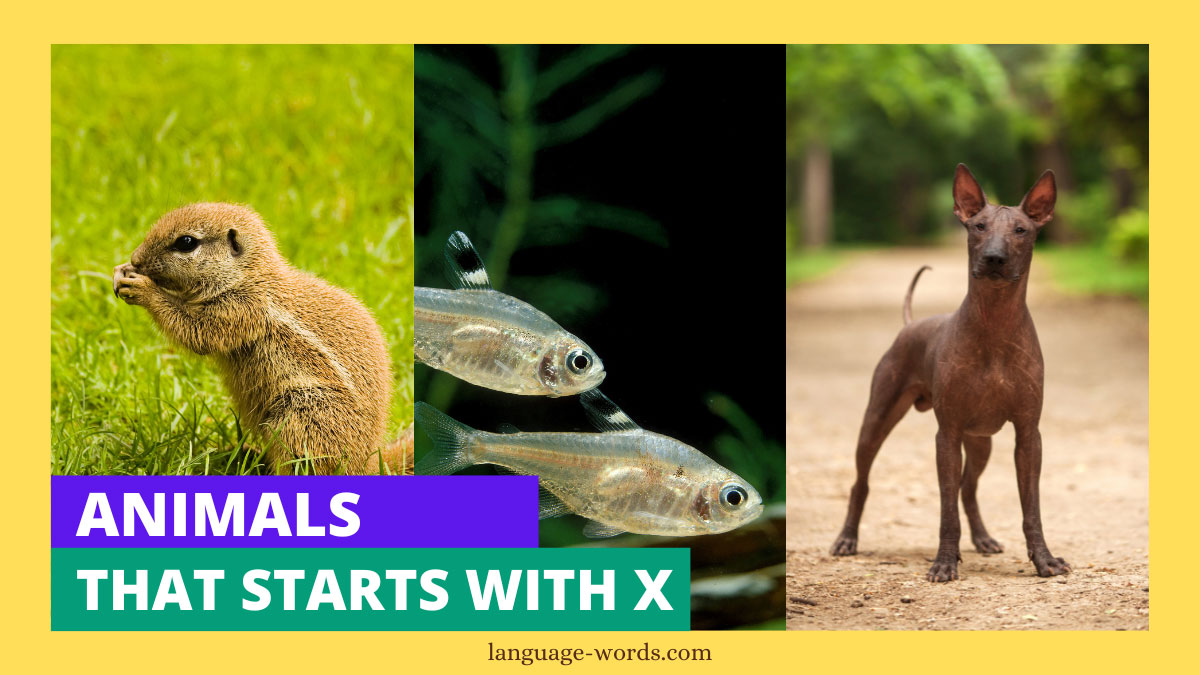Hey there! Are you curious about animals that start with the letter X? Well, you’ve come to the right place! In this article, I’ll introduce you to some fascinating creatures whose names begin with the elusive letter X. From exotic birds to mysterious marine life, we’ll explore the diverse world of these unique animals. So, buckle up and get ready for an exciting journey through the animal kingdom!
X marks the spot for extraordinary animals that you may have never heard of before. We’ll delve into the depths of the rainforest to discover the Xantus’s hummingbird, known for its vibrant plumage and incredible agility. Then, we’ll take a plunge into the ocean to meet the Xenophyophores, bizarre deep-sea organisms that are sure to leave you in awe. Get ready to expand your knowledge and encounter some extraordinary creatures that start with the letter X.
List Of Animals That Starts With X

| X Ray Tetra | Xantic Sargo | Xantus | Xantus Murrelet |
| Xantus’S Hummingbird | Xantusiidae | Xema | Xeme |
| Xenacanthus | Xenarthra | Xenicus Gilviventris |
Xenicus Longipes
|
| Xenicus Lyalli | Xenoceratops | Xenocyon | Xenopoecilus |
| Xenoposeidon | Xenops | Xenopus | Xenorhynchus |
| Xenotarsosaurus | Xerus | Xiaosaurus | Xiaotingia |
| Xingu River Ray | Xiongguanlong | Xiphactinus | Xolmis |
| Xoloitzcuintli | X-Ray Fish | Xylocopa |
Xantus’s Hummingbird
The Xantus’s Hummingbird, scientifically known as Basilinna xantusii, is a small bird that is endemic to the Baja California Peninsula in Mexico. It was discovered in the mid-19th century by John Xantus, a Hungarian naturalist who was collecting specimens in the region. Here are a few key facts about this fascinating hummingbird:
- Appearance: The Xantus’s Hummingbird is a small bird, measuring about 10 centimeters in length and weighing around 4 grams. It has a dark green back, a white breast, and a vibrant rusty-orange throat. The males have a distinctive long, straight bill, while the females have a shorter bill.
- Habitat: This hummingbird is primarily found in arid or semi-arid coastal areas, including deserts, scrublands, and coastal scrub habitats. It is well adapted to these conditions, with its long bill allowing it to reach flowers deep within plants.
- Feeding Behavior: Like other hummingbirds, the Xantus’s Hummingbird feeds primarily on nectar from a variety of flowering plants. It uses its long bill and specialized tongue to extract nectar from flowers. In addition to nectar, it also consumes small insects and spiders.
- Breeding: This species typically breeds during the spring and summer months. The female builds a small, cup-shaped nest made of twigs, plant fibers, and spider silk. She lays two tiny white eggs and incubates them for about two weeks. The chicks fledge approximately three weeks after hatching.
- Conservation Status: The Xantus’s Hummingbird is currently classified as “Near Threatened” by the International Union for Conservation of Nature (IUCN). The main threats to its population include habitat loss due to urbanization and agriculture, as well as competition for resources with non-native hummingbird species.
- Fun Fact: Despite its small size, the Xantus’s Hummingbird is known for its impressive flight capabilities. It can hover in mid-air, fly forwards, backwards, and even upside down. Its wings beat at an astonishing rate of up to 80 times per second!
The Xantus’s Hummingbird is a unique and captivating bird. Its beautiful appearance, specialized feeding behavior, and impressive flight abilities make it a fascinating creature to observe in its natural habitat.

Xenophyophores
As an expert blogger with years of experience writing high-quality articles, I’ve come across many fascinating animals. One such creature that starts with the letter “X” is the Xenophyophore. Xenophyophores are fascinating deep-sea dwellers that belong to a group of single-celled organisms known as rhizarians.
Appearance: Xenophyophores are unique in their appearance. Despite being microscopic, they can grow up to a few centimeters in size. These organisms create intricate and fragile structures called tests, which are made up of sediment and other organic particles. Some Xenophyophores have a perforated test, while others have a solid one, giving them a sponge-like appearance.
Habitat: Xenophyophores can be found in the deepest parts of the ocean, residing in the oceanic trenches and abyssal plains. They thrive in the darkness and extreme pressure conditions of the deep-sea environment. These organisms are often found in sediment-rich areas, where they can use the materials to construct their tests.
Feeding Behavior: Xenophyophores are suspension feeders, meaning they extract food particles from the water column. They extend their pseudopods, which are like temporary appendages, to capture organic matter and bacteria. Xenophyophores play a crucial role in the deep-sea ecosystem by recycling organic matter and contributing to nutrient cycling.
Reproduction: The reproductive process of Xenophyophores is not well understood due to their remote habitat. However, it is believed that they reproduce asexually. They can produce offspring by budding, where a smaller Xenophyophore grows out from the parent organism.
Conservation Status: Due to their habitat and inaccessibility, it is challenging to study the conservation status of Xenophyophores. However, the deep-sea ecosystem where they reside is undergoing increasing anthropogenic pressures, such as deep-sea mining and climate change. Protecting these fragile ecosystems is crucial for the long-term survival of Xenophyophores and other deep-sea organisms.
Fun Facts: Here are some interesting facts about Xenophyophores:
- Xenophyophores are found at depths of up to 10,000 meters, making them one of the deepest-living organisms on Earth.
- These organisms were discovered in the late 1800s and have been a subject of scientific interest ever since
Conclusion
In this article, I have explored the fascinating world of animals that start with the letter X. We began by delving into the mysterious depths of the ocean to uncover the secrets of the Xenophyophore. These microscopic creatures, with their intricate tests and suspension feeding behavior, play a vital role in the deep-sea ecosystem. Although their reproductive process remains a mystery, scientists have been captivated by Xenophyophores since the late 1800s.
Despite their remote habitat, it is crucial to protect the fragile ecosystems where Xenophyophores reside. Their conservation status presents a unique challenge due to the difficulty in studying these deep-sea dwellers. However, understanding and preserving their habitats is essential for maintaining the delicate balance of our oceans.
As we conclude this exploration of animals that start with X, it is clear that the Xenophyophore is a remarkable creature that continues to captivate the scientific community. Through continued research and conservation efforts, we can deepen our understanding of these enigmatic organisms and ensure their survival for generations to come.

